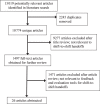Feedback and Assessment Tools for Handoffs: A Systematic Review
- PMID: 28261391
- PMCID: PMC5319625
- DOI: 10.4300/JGME-D-16-00168.1
Feedback and Assessment Tools for Handoffs: A Systematic Review
Abstract
Background: Resident handoff communication skills are essential components of medical education training. There are no previous systematic reviews of feedback and evaluation tools for physician handoffs.
Objective: We performed a systematic review of articles focused on inpatient handoff feedback or assessment tools.
Methods: The authors conducted a systematic review of English-language literature published from January 1, 2008, to May 13, 2015 on handoff feedback or assessment tools used in undergraduate or graduate medical education. All articles were reviewed by 2 independent abstractors. Included articles were assessed using a quality scoring system.
Results: A total of 26 articles with 32 tools met inclusion criteria, including 3 focused on feedback, 8 on assessment, and 15 on both feedback and assessment. All tools were used in an inpatient setting. Feedback and/or assessment improved the content or organization measures of handoff, while process and professionalism measures were less reliably improved. The Handoff Clinical Evaluation Exercise or a similar tool was used most frequently. Of included studies, 23% (6 of 26) were validity evidence studies, and 31% (8 of 26) of articles included a tool with behavioral anchors. A total of 35% (9 of 26) of studies used simulation or standardized patient encounters.
Conclusions: A number of feedback and assessment tools for physician handoffs in several specialties have been studied. Limited research has been done on the studied tools. These tools may assist medical educators in assessing trainees' handoff skills.
Conflict of interest statement
Conflict of interest: The authors declare they have no competing interests. Some preliminary data were presented at the Minority Health Disparities Resource Center Summer Research Display, Birmingham, Alabama, July 2014; the Dale J. Benos Medical Student Research Day, Birmingham, Alabama, October 28, 2014; the American Society of Anesthesiologists Conference, San Diego, California, October 24, 2015; and the Accreditation Council for Graduate Medical Education Annual Educational Conference, National Harbor, Maryland, February 26, 2016.
Figures
References
-
- Patterson ES, Wears RL. . Patient handoffs: standardized and reliable measurement tools remain elusive. Jt Comm J Qual Patient Saf. 2010; 36 2: 52– 61. - PubMed
-
- Ende J. Feedback in clinical medical education. JAMA. 1983; 250 6: 777– 781. - PubMed
-
- Newble DI, Jaeger K. . The effect of assessments and examinations on the learning of medical students. Med Educ. 1983; 17 3: 165– 171. - PubMed
Publication types
MeSH terms
LinkOut - more resources
Full Text Sources
Other Literature Sources
Miscellaneous


